Ray Dalio最成功的企业家之一s of our time, is humble about what he knows. The founder of Bridgewater Associates, a prominent investment management firm, and the world’s 79th wealthiest person, he understands what it takes to be successful. Dalio attributes his success to a set of principles that help him to discern what is true. He believes that following his principles can get you what you want from life. He crafted these principles by making many mistakes, but then reflecting on them well. His mantra for success? Strive for a lot, and fail well.
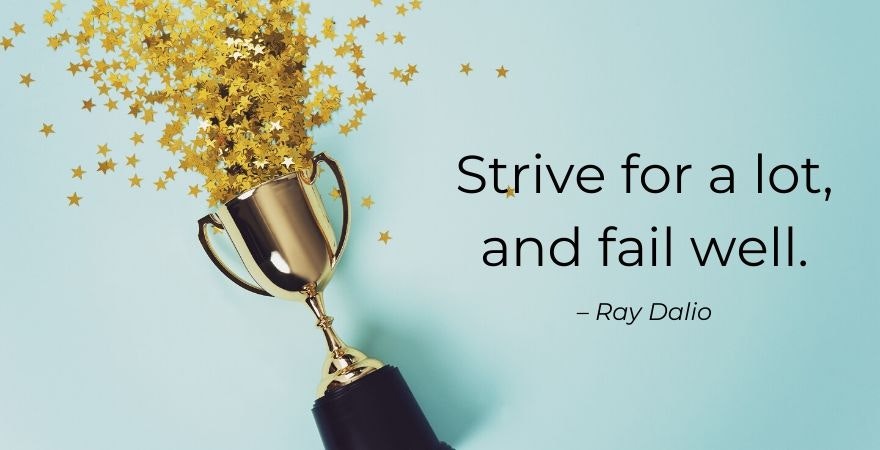
Dalio’s ‘Principles: Life and Work’ book is structured into three sections:
- The first section looks at how Dalio’s principles were formed from his experiences.
- The second section looks specifically at principles for life. Here, Dalio demonstrates how these principles can be applied to the natural world, in relationships, business, and policymaking.
- The third section discusses work principles, where Dalio uses his experience as the founder of Bridgewater to show how the use of radical truth and radical transparency can transform an organization.
这个总结的“原则”Ray Dalio总和marize each of these sections in turn, providing you with all the key takeaways.
Post Contents
- Section 1: Where I’m coming from
- Section 2: Life Principles
- Section 3: Work Principles
- How to get the culture of your workplace right
- 1. The company must put their trust in radical truth and radical transparency
- 2. Cultivate meaningful work and meaningful relationships
- 3.营造一种文化,在这种文化中,错误是容忍,but it’s unacceptable not to learn from them
- 4. Get and stay in sync
- 5. Believability weight your decision making
- 6. Recognize how to get beyond disagreements
- How to get the right people for your workplace
- How to build and evolve your machine
- 1. Manage your company as if you were operating a machine trying to achieve a goal
- 2. Perceive and don’t tolerate problems
- 3.Diagnose problems to get at their root causes
- 4. Design improvements for your machine to get around your problems
- 5. Use tools and protocols to shape how work is done
- 6. Don’t overlook governance
- How to get the culture of your workplace right
- Tying ‘Principles’ together
- Want to Learn More?



Section 1: Where I’m coming from
Ray Dalio’s early years
Dalio was born in 1949 to a middle-class family in Long Island, New York, the son of a jazz musician and a stay-at-home mom. From an early age, he learned that one of his most significant weaknesses was his rote memory, and he had a particular dislike for following instructions. However, he was incredibly curious and enjoyed finding things out by himself.
Ray disliked school. He found everything uninteresting, and couldn’t understand why doing well was important, apart from keeping his mother happy. When he didn’t want to do something, it was impossible to get him to do it, but if he was interested in it, nothing could hold him back. Although he hated doing chores, he had many part-time jobs as he loved having his own money. At the age of twelve, while working as a caddy driver at a golf course, he overheard some golfers talking about the stock market. He got so excited by it that he took his wages from the golf club and invested them in stocks.
Dalio’s college and early work experiences
In his late teens, Dalio went to a local college called C.W.Post, where he got in on probation due to his C-grade average. However, he loved college as he could learn about the things that interested him. Consequently, for the first time in his life, he got good grades. It was at this time that he also got into meditation, which he’s continued to practice throughout his life to great effect. Like Steve Jobs, Ray’s formative college years coincided with the era of free love, psychedelics, and a rejection of conservative tradition.
Graduating with a near-perfect grade point average and majoring in finance, Dalio got into Harvard Business School. The summer before he began, he got a job as a clerk on the floor of the New York Stock Exchange. Here, he learned that for every action taken, there is a consequence that is roughly proportionate to that action, and that creates an equal and opposite reaction. One example being easy money and credit, causing high inflation and, therefore, the restraining of money and credit.
After graduating from Harvard with an MBA, Dalio worked at a couple of brokerage firms before punching his boss in the face, and getting fired! Nevertheless, all of the brokers he worked with, and their clients, kept coming back to him for his advice. This was when Dalio started Bridgewater Associates—from out of his two-bedroom apartment.
From here, he began to develop early computer models that could predict the market based on various pieces of data that were entered into it. It was at this time that he started to do four things that he would continue to do throughout his working life:
- Visualize complex systems as machines
- Work out the cause and effect relationships between them
- Write down principles on how to deal with them
- Feed this data into a computer so it could make decisions “for” him
While making money was good, Dalio discovered that having meaningful work was more important.
Coming back from the financial abyss, and the first principles
After losing a lot of money in the late seventies and nearly going broke, Dalio came up with the following four principles:
- Find the smartest people who oppose your opinion to try to understand their perspective
- Know when not to have an opinion
- Develop, test, and then systematize a set of timeless principles
- Balance risks to keep big potential gains but reduce massive losses
He picked up the pieces and decided to view his loss as an educational experience. As a result, Bridgewater slowly began to grow, and by the mid-‘80s, he realized that the company excelled at doing two things:
- Making calls on the interest-rate and currency markets
- Managing companies’ interest rates and currency exposures
From here, Bridgewater started managing the accounts of some big clients, including the World Bank’s pension fund. Before long, they became the top-performing US bond manager in the world. After initially giving Bridgewater a $5 million investment to look after, by the end of the ‘80s, the World Bank’s initial investment had grown to $180 million.
Making Bridgewater a success
By 1995, Bridgewater had 42 employees and $4.1 billion under management. By 2000, they were managing $32 billion, and they had over 80 employees. By 2003, Ray decided Bridgewater needed to become a certified institution rather than a well-performing investment manager. This change meant developing new technology and infrastructure and hiring additional tech employees.
By 2008, they had 738 employees. They successfully predicted the 2008 economic crash, and during a period where most investors recorded losses of 30 percent, their flagship fund made over 14 percent. By 2010, their returns were the highest they’d ever been, which Ray attributes to the fact that the computers they’d programmed were processing all the information they inputted to great effect.
By this point, Bridgewater, and Ray, in particular, had started to garner a lot of attention and were frequently being sensationalized in the press. Becoming frustrated with the mischaracterizations of Bridgewater as being a cult, Ray decided to publish his principles online to set the record straight. Since then, more than three million people have downloaded them.
Entering the third stage of his life, and the writing of the ‘Principles’ book
As Ray sees it, life is comprised of three phases:
- We are dependent on others
- Others depend on us
- No one depends on us, and we are free to savor life
From 2010, Ray began to look for successors at Bridgewater. He was no longer as intellectually or emotionally stimulated by the idea of being successful and was more interested in the people he cared for being successful without him. In 2011, Ray announced that he would be stepping down as CEO, and Greg Jensen and David McCormick would replace him with an “up-to-ten-year transition plan.”
At the time of writing ‘Principles’ in 2017, Ray viewed this year as his final year in the handover before moving full-time into stage three of his life. The writing of ‘Principles’ was the accumulation of all he had learned during his long career, in the hope that he could help others to create their principles and to achieve success.
Section 2: Life Principles
Embrace reality and deal with it
Dalio states that there is nothing more important than first, understanding how reality works, and second, learning how to deal with it. The first step to getting a better idea of what reality is is to be a hyperrealist. This understanding prevents you from getting lost in unrealistic dreams that will never come to fruition. Dalio argues that the formula to success is as follows:
Dreams + reality + determination = a successful life.
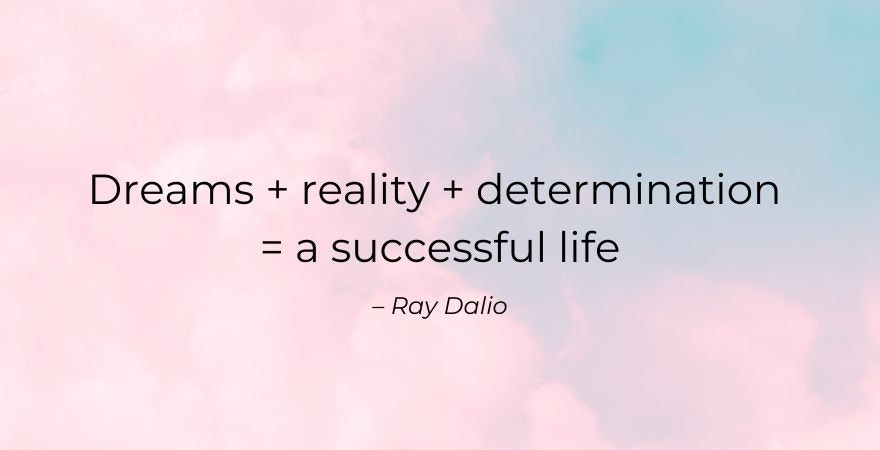
The next step in this process is to accept that a good outcome relies on an accurate idea of reality. Many people ignore the truth when it contains harsh realities. This ignorance prevents them from progressing in any lasting or beneficial way. To accept reality as it is, you need to be both radically open-minded and radically transparent. This open-mindedness helps you learn quickly and effectuate effective change. The more open-minded you are, the less you are likely to lie to yourself.
If you want to see how reality works, Dalio suggests observing nature. Our universe is governed by a system of laws that underpin the nature of our reality. When looking at the evolution of the brain, in contrast to animals, humankind often struggles to reconcile emotions and instincts (which we inherited from our animal ancestors) with reasoning (a unique facet of the human brain). In this battle, we lose sight of the true nature of reality. Dalio offers a few tips to overcoming this dilemma:
- Don’t fixate on the way things “should” be but rather how they are
- To be “good” something must operate consistently within the laws of reality and simultaneously contribute to the evolution of the whole
- Understand that evolution is the most significant force in the universe, it’s the only true permanent thing that drives everything
- Evolve or die. This expression applies to all areas of life, be it the individual, countries, companies, or economies. The key to this is to fail, learn, and improve quickly
On that note, Dalio states that the greatest accomplishment and reward of life is to evolve. Instinctually, we want to get better at things. We want to improve. That is because we are driven to evolve. The correlation between success and the drive to evolve is embodied in the following five points:
- An individual’s incentives must always be aligned with a group’s goals. Evolution works in the same way
- Therefore, when you contribute to the whole, not just to further yourself, you will be rewarded
- Using trial and error to adapt is essential and invaluable
- 理解你同时everything and nothing, but you can choose which one you want to be. From the perspective of nature, we are insignificant, but from the perspective of our brains, we are our entire universe. We can choose to make small, modest contributions in our short lifespans
- What you are depends on your perspective
Nature, Dalio argues, also gives us some invaluable lessons. “No pain, no gain” is one such lesson as to evolve, we must endure struggle and pain. To gain strength, one’s limits must be tested, which is a painful process. Yet, most people instinctively avoid pain and, therefore, avoid growth. However, to truly evolve as an individual, you need to experience pain but then reflect on it. Instead of avoiding it, you must move towards it as it contains some of your most important lessons.
Committed towards the goal of seeing reality for what it is, Dalio posits that you should look at how you operate in the world from a more removed perspective. Viewing yourself as a machine that works within a machine allows you to comprehend that you can alter specific processes to produce better outcomes. The way to optimize your “machine” is to compare your results with your goals. The most successful people are those who can see beyond themselves, view their behavior objectively, and make necessary alterations to move towards a better comprehension of reality.
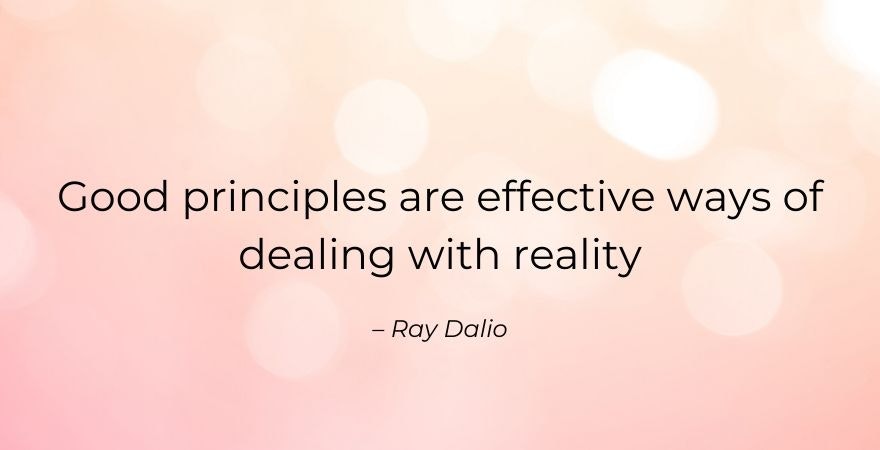
Use the 5-step process to get what you want out of life
Dalio believes that the evolutionary process that you must undergo to become successful happens across five stages:
- Having clear goals
- Identifying the problems that prevent you from achieving these goals
- Getting to the root cause of these problems
- Designing plans to help you overcome these root causes
- Enforcing these plans to get your desired results
Breaking this process down somewhat, Dalio states that by picking your goals, you determine your direction. As you move in this direction, you inevitably experience a series of problems, some of which will illuminate your greatest weaknesses. Here, you have a choice. You either move towards the pain that this causes, learn from your failings, and evolve, or you can ignore the problem and not move toward your goal.
By honestly looking at your problems and devising a plan to overcome them, you open yourself up to the chance of evolving. However, to evolve swiftly, you’ll need to go through this process quickly and continuously, each time setting your goals a little higher. This 5-step process is iterative, which means that if you complete one step, you have all the information at hand to lead you on to the next one.
If you find yourself getting frustrated with this process, Dalio suggests imagining that your life is a game in which overcoming your challenges is your goal. Once you accept the rules of the game, you gradually become accustomed to the discomfort that accompanies the constant feeling of frustration. As you get used to cycling through this evolutionary process of failing, learning from your mistakes, and moving on to the next challenge, you become more adept and prepared. Ultimately, almost nothing can prevent you from achieving success if you have flexibility and self-accountability.
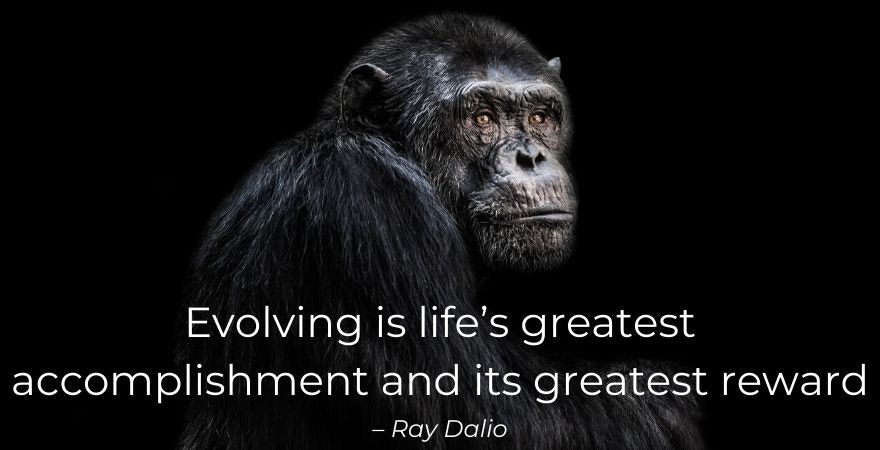
Be radically open-minded
Dalio states that being radically open-minded is one of the most, if notthemost, important features you require if you want to be successful. You prevent yourself from getting what you want out of life because of two barriers: Your ego and your blind spots. These two barriers stop you from seeing reality objectively. Radical open-mindedness allows you to overcome this.
If you can bring awareness to the fact that you have blind spots, you are more likely to reach out to someone who can see these issues clearer than you, which leads you to make better decisions. Radical open-mindedness helps you to make the most optimal choices. It allows you to explore varying points of view without letting the trappings of your ego or your blind spots get in the way. It requires you to replace your notion of always being right, with the desire to learn what is true.
An essential caveat here is that you should focus on achieving your goal, not on looking good, and to realize that you can’t produce something of worth without learning along the way. The goal is to discover the best solution, not merely the best solution that you can come up with on your own. To do this effectively, Dalio suggests questioning those you believe to be experts in a particular field and encouraging them to engage in a thoughtful disagreement with you. This allows you to see any blind spots you may have overlooked, humbles your ego, and allows you to learn something along the way.
Understand that people are wired differently
There are as many realities as there are brains. Every individual is wired differently, so if you want to understand what is true, you first need to understand your brain. A great deal of power comes in knowing first, how you are wired, and second, how others are wired. Like everyone else, you are born with a selection of attributes that can either hurt you or help you: the more extreme a particular attribute, the more extreme the potential for either good or bad.
To grasp how you’re wired, you need to understand what your greatest brain challenges are and how to control them to achieve your goals. Your conscious mind is in a constant battle with your subconscious. Loosely speaking, this is a battle between your feeling and your thinking brain. To be able to reflect on why a specific emotion may be hijacking your reasoning functionality is essential for achieving your goals as it allows you to see reality more objectively.
A further way to better understand how yourself and others are wired is to undergo a psychometric assessment. There are four assessments that Dalio uses:
– The Myers-Briggs Type Indicator
– The Workplace Personality Inventory
– The Team Dimensions Profile
– The Stratified Systems Theory
Using a mixture of the above assessments and his experiences, Dalio states that there are a few key personality traits that we all have in varying measures:
– Introversion vs. extroversion
– Intuiting vs. sensing
– Thinking vs. feeling
– Planning vs. perceiving
– Creators vs. refiners vs. advancers vs. executors vs. flexors
– Focusing on tasks vs. focusing on goals
By understanding how people work, and using psychometric tests, you’ll be able to get the right people into the right roles, which is the key to achieving your goals.
Learn how to make decisions effectively
称自己为“专业decision-maker,” Dalio posits that most of your everyday decisions are made in your subconscious. This poses a challenge to making your decisions in a reliable, systematic, and repeatable manner. However, this is what Dalio has tried to do throughout his career to great success. To help you do the same, he provides a dozen pointers to consider when making a decision:
- Recognize that emotions pose the greatest threat to making decisions and that arriving at a decision is a two-step process of learning and then deciding
- Synthesize your current situation, i.e., identify the factors that are important to your ongoing decision-making process
- Synthesize the situation through time, i.e., observe how different factors behave over time to get a better understanding of their true nature
- 透视图之间切换。这意味着看到机器人h the big picture, and the subtle nuances of your decision-making process
- Rely on logic, reasoning, and common sense if you want to get the best picture of reality
- Arrive at your decisions as you would if you were making a value calculation. Think of each decision you make as a bet with a probability of it being right or wrong
- Choose whether you need to prioritize acquiring more information before making a decision, or whether it’s more valuable to make a quick decision
- Simplify your decision-making process by removing all of the superfluous information
- Use principles so you can be clear about the criteria you are using when arriving at a decision
- Weight your decision-making according to believability, i.e., get the opinion of some trusted, smart experts on your decision before you commit to it
- Convert your principles into algorithms so a computer can make decisions alongside you
- However, don’t fully trust AI without having a solid understanding of how it works
Section 3: Work Principles
How to get the culture of your workplace right
To create a cohesive, productive, successful workforce, you need to ensure that the company culture is exemplary. A company with a remarkable culture will bravely look at problems and disagreements and manage and solve them well. It will also thrive on creating and building innovative products and systems. According to Ray, to create an outstanding company culture, you need to follow six basic principles.
1. The company must put their trust in radical truth and radical transparency
To foster a radical culture, the company must understand that it has nothing to fear from knowing the truth; it can only benefit from it. To get to a greater sense of truth, each employee must be encouraged to have integrity, and to demand it from others. This means being true to themselves and not presenting themselves to be one way externally, while internally, feeling differently.
To encourage employees to act with integrity, an environment of openness combined with an obligation to speak up when they disagree with something must be fostered. This is then coupled with radical transparency that allows issues to come to the surface more readily. To be radically transparent means sharing things that are particularly painful to share, and to make few exceptions in which things are not shared as otherwise, trust is lost.
2. Cultivate meaningful work and meaningful relationships
Meaningful relationships are the cornerstone upon which a culture of excellence is founded. If the majority of your workforce cares deeply about each other, they will support and take care of the community, which results in better work and better relationships. To create a depth of meaningful relationships, each employee must be loyal to the organization’s shared mission, but not to any individual who resists it. This prevents any fractions from forming.
It’s also worth considering that many people may pretend to be working in your interest while operating on their own. In these cases, don’t be naive, and don’t be loyal to these individuals. Instead, treasure those who are capable and who will treat you well, even when your back is turned.
3.营造一种文化,在这种文化中,错误是容忍,but it’s unacceptable not to learn from them
成功和失败的区别people is that the former learn from their mistakes, while the latter doesn’t. While mistakes are painful, pain is a message that something is wrong and needs to be changed—it should be listened to. By recognizing that mistakes are a natural part of the evolutionary process, you’re in a better position to observe patterns of errors and to reflect on them.

4. Get and stay in sync
Getting in sync as a team means open-mindedly and assertively rectifying both simple misunderstandings and fundamental disagreements. To do this, the team needs to recognize that conflicts are essential for healthy relationships as they highlight areas where everyone may not be on the same page. In these moments, it’s important to stay open-minded but also to be assertive. If the person you are trying to get in-sync with is close-minded, you’re wasting your time discussing the matter with them until they can open their minds. If you find that you can’t reconcile some major differences, you should consider whether the relationship is worth saving.
5. Believability weight your decision making
The best decisions are made when the most capable people work through their disagreements with other capable people. This is what Dalio means by “believability weighting.” This is the process of identifying the most capable people who disagree with you, trying to understand their point of view, and getting a grasp on how they reached their opinions.
6. Recognize how to get beyond disagreements
Rarely is a dispute resolved to the equal satisfaction of both parties. Legal systems have a set of procedures in place to determine what’s true and what should be done about it. The same is true of workplace disputes, but instead of laws, great companies use principles to manage disagreements well. Important conflicts mustn’t be left unresolved, and once a decision is made, everyone should get behind it.
How to get the right people for your workplace
While getting the company culture right is important, getting the right people involved in your company is even more critical, as they dictate culture, for better or for worse. Culture and employees are symbiotic as a good culture attracts good people. Dalio identifies three key ways to make sure you are hiring the right people.
1. Remember that the who is more important than the what
People often focus on what should be done as opposed to who should be doing it. The most important decision that a company makes is who to choose as its responsible parties. The main responsible party will also be the person who will bear the consequence of all that is done. With this in mind, every employee should have someone to report to.
2. Hire right, because the penalties for hiring wrong are huge
Too often, people employ potential employees because they like them, and they think similarly to themselves. This is a trap, one that Dalio fell into at the beginning of Bridgewater, and that led to many problems down the road. To hire well, you first need to consider which values, abilities, and skills you are looking for in a prospective employee. You should make finding the right employee a systematic and scientific process. Personality assessments may prove useful in this endeavor.
3.Constantly train, test, evaluate, and sort people
For your company to improve, both your people and your design must evolve. When you get employee evolution right, the returns are exponential. By giving each employee a frank assessment of their strengths and weaknesses, you can find the best match for them within the company. While some people can find this process hurtful, it’s essential to provide each employee with constant feedback and to make sure that you evaluate accurately, not kindly, as tough love is the hardest but also the most important type of love to give.

How to build and evolve your machine
Successful people can objectively see themselves and others within a company as a machine. Having got your culture and your people right, you now need to know how to improve your company. Dalio explains how to do so in the following six steps:
1. Manage your company as if you were operating a machine trying to achieve a goal
To do this effectively, you must work with your employees to understand how your lower-level goals feed into your higher-level goals and values. By clearly assigning responsibilities and probing deep to understand what you can expect from your machine, you will be better able to grasp the truth of how it’s currently functioning. This also means holding yourself and your employees accountable and communicating your plans clearly, with clear metrics that indicate whether you are on track to success.
2. Perceive and don’t tolerate problems
Every problem that you encounter is an opportunity to improve your machine. However, most people overlook the things that aren’t going well and, instead, focus on the things that are going smoothly. This is a trap and will undermine your progress significantly. To perceive your problems, compare your outcomes with your goals, and don’t be afraid to fix the challenging things.
3.Diagnose problems to get at their root causes
Once you perceive a problem, your mission is to identify its root cause. To diagnose an issue thoroughly, you should ask yourself the following three questions:
- Is the outcome good or bad?
- Who is responsible for this outcome?
- If it’s a bad outcome, is the responsible party at fault, or is it bad design?
4. Design improvements for your machine to get around your problems
Now that you’ve identified your problems, you need to design paths for solving them. Designs need to be based on a deep, thorough understanding, and you must ensure that you’re looking at your problems objectively. Design is an iterative process, and between the painful present and the better tomorrow, there is a challenging processing period.
5. Use tools and protocols to shape how work is done
To implement success-sustaining habits within an organization, tools and protocols need to be introduced. Embedding systematized principles within these tools produces real behavioral change as it encourages an internalization of habituated learning.
6. Don’t overlook governance
Governance is the system by which people and processes are removed if they are not performing. An organization is lost without solid governance. Power must be put in the hands of the most competent people in key roles who are aligned with the company’s values and that do their jobs well while observing the power of others.
Tying ‘Principles’ together
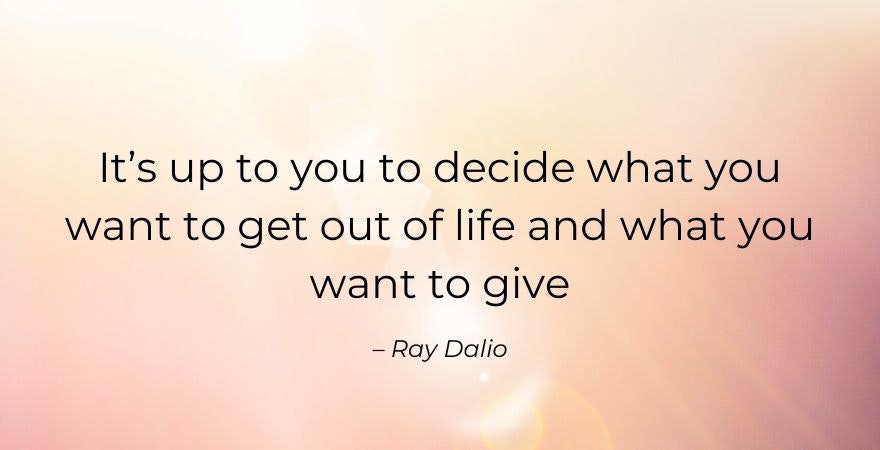
By providing these life and work principles, Dalio trusts that when you’re struggling to achieve your goals, that you will struggle well, and ultimately, evolve. He hopes that you will be inspired to write down a set of principles for yourself and that they will guide you to whatever success looks like for you. Ultimately, it’s up to you to decide what you want to get out of life and what you want to give.
You can buy‘Principles’ by Ray Dalio onAmazon.






